 April What'sNEW Jan - Mar 2025 April What'sNEW Jan - Mar 2025
| 31 Mar 2025 |
What'sNEW about HGT


|
...three genes encoding cold-shock proteins (CSPs) were transferred from bacteria to ...a tribe of the grass family that includes ...wheat, barley and rye. (HGT delivers important eukaryotic genes from bacteria.)
 "Horizontally acquired CSP genes contribute to wheat adaptation and improvement," by Wang, K., Guo, G., Bai, S. et al, doi:10.1038/s41477-025-01952-8, Nat. Plants, 27 Mar 2025. "Horizontally acquired CSP genes contribute to wheat adaptation and improvement," by Wang, K., Guo, G., Bai, S. et al, doi:10.1038/s41477-025-01952-8, Nat. Plants, 27 Mar 2025.
 Thanks, Google Alerts. Thanks, Google Alerts.
 Viruses and Other Gene Transfer Mechanisms cites >1,000 examples of HGT into eukaryotes. Viruses and Other Gene Transfer Mechanisms cites >1,000 examples of HGT into eukaryotes.
If life can come from space, it must be able to remain viable without metabolism for very long times. Now a study observes, under the Baltic Sea, ...microscopic algae that had remained dormant for c. 7000 years in anoxic sediments ...resumed growth when exposed to oxygen and light. Could large comets also hold dormant microbial life in anoxic sediments? Just a thought.
 "Resurrection of a diatom after 7000 years from anoxic Baltic Sea sediment," by Sarah Bolius et al, doi:10.1093/ismejo/wrae252, The ISME Journal, 03 Jan 2025. "Resurrection of a diatom after 7000 years from anoxic Baltic Sea sediment," by Sarah Bolius et al, doi:10.1093/ismejo/wrae252, The ISME Journal, 03 Jan 2025.
 "After 7,000 years ...researchers bring prehistoric algae back to life," via Phys.Org, 28 Mar 2025. "After 7,000 years ...researchers bring prehistoric algae back to life," via Phys.Org, 28 Mar 2025.
 29 Jan 2023: "Wet Panspermia" elaborates even beyond this speculation. 29 Jan 2023: "Wet Panspermia" elaborates even beyond this speculation.
 Bacteria... discusses the surprising versatility and hardiness of microbial life. Bacteria... discusses the surprising versatility and hardiness of microbial life.
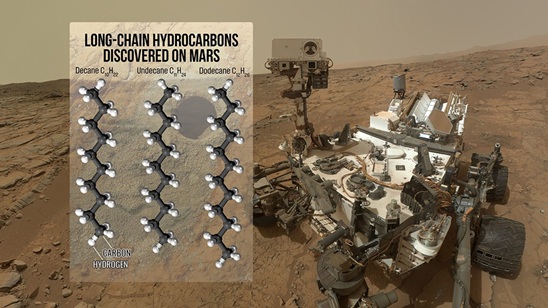 Organic molecules preserved in ancient Martian rocks ...could be chemical biosignatures.
Organic molecules preserved in ancient Martian rocks ...could be chemical biosignatures.
 "Long-chain alkanes preserved in a Martian mudstone," by Caroline Freissinet et al, doi:10.1073/pnas.2420580122, PNAS, 24 Mar 2025. "Long-chain alkanes preserved in a Martian mudstone," by Caroline Freissinet et al, doi:10.1073/pnas.2420580122, PNAS, 24 Mar 2025.
 "NASA's Curiosity Rover Detects Largest Organic Molecules Found on Mars," JPL (with 90-sec video), 24 Mar 2025. "NASA's Curiosity Rover Detects Largest Organic Molecules Found on Mars," JPL (with 90-sec video), 24 Mar 2025.
 "Curiosity rover detects long-chain carbon molecules on Mars," by Paul Voosen, Science, 24 Mar 2025. "Curiosity rover detects long-chain carbon molecules on Mars," by Paul Voosen, Science, 24 Mar 2025.
 Life on Mars! discusses evidence from ALH84001, Viking, the Opportunity rover and more. Life on Mars! discusses evidence from ALH84001, Viking, the Opportunity rover and more.
Directed Panspermia? In a speculative paper, Soryl and Sandberg ask whether this is something we on Earth should attempt, given that it might lead to suffering. I am immediately reminded of a philosophical question: why would an all-powerful and benevolent god permit the suffering we experience on Earth? For directed panspermia, I think other issues would matter more. Besides, natural panspermia has probably already been there.
 "To Seed or Not to Seed: Estimating the Ethical Value of Directed Panspermia," by Asher Soryl and Anders Sandberg, Acta Astronautica, online 22 Mar 2025. "To Seed or Not to Seed: Estimating the Ethical Value of Directed Panspermia," by Asher Soryl and Anders Sandberg, Acta Astronautica, online 22 Mar 2025.
Online commentary about the topic is also thought-provoking, and edifying. Paul Gilster reminds us that panspermia is no longer a fringe theory. I especially enjoyed knowing more about Hans Richter (1808-1876).
 "The Ethics of Spreading Life in the Cosmos," by Paul Gilster, Centauri Dreams, 25 Mar 2025. "The Ethics of Spreading Life in the Cosmos," by Paul Gilster, Centauri Dreams, 25 Mar 2025.
All life comes from cells throughout eternity — Richter, c.1865, trans. by Gister.
 How is it Possible? includes my early speculations on directed panspermia, with various updates. How is it Possible? includes my early speculations on directed panspermia, with various updates.
...It would really be very surprising... if the galaxy is not just teeming with life — Chandra Wickramasinghe, c. 1978, "The Sky at Night...," 1-minute video from interview by Patrick Moore, also with Fred Hoyle, Vimeo online 2024.
 Thanks, Brian Cory Dobbs. Thanks, Brian Cory Dobbs.
 Hoyle and Wickramasinghe's Analysis of Interstellar Dust has background. Hoyle and Wickramasinghe's Analysis of Interstellar Dust has background.
...we find GS-z14 to be surprisingly metal-enriched ...a mere 300 Myr after the Big Bang.
 "Oxygen discovered in most distant known galaxy," ESO via Phys.Org, 20 Mar 2025; re: "Oxygen discovered in most distant known galaxy," ESO via Phys.Org, 20 Mar 2025; re:
 "Detection of [Oxygen...] at z=14.1793," by Sander Schouws et al, The Astrophysical Journal (draft), 17 Mar 2025. "Detection of [Oxygen...] at z=14.1793," by Sander Schouws et al, The Astrophysical Journal (draft), 17 Mar 2025.
 The End and the Big Bang has more about alternatives to the BB theory. The End and the Big Bang has more about alternatives to the BB theory.
The exchange of material between plants and fungi converted Earth's early rock into soil — a process that transformed the biosphere....
 "Revealing how fungi build planet-altering 'road' networks," by Neo D. Martinez and Gianna L. Marschmann, Nature, 06 Mar 2025. "Revealing how fungi build planet-altering 'road' networks," by Neo D. Martinez and Gianna L. Marschmann, Nature, 06 Mar 2025.
 Gaia introduces this theory, with examples and updates. Cosmic ancestry depends on Gaian processes. Gaia introduces this theory, with examples and updates. Cosmic ancestry depends on Gaian processes.

A comprehensive, computable representation of the functional repertoire of all macromolecules encoded within the human genome is a foundational resource for biology and biomedical research. Genomicists studying model species like fruitflies, mice, yeast, aradopsis and others, calling themselves the Gene Ontology Consortium, have collaborated to assemble such a resource. The project is awsome in scope and the potential benefits are countless, especially for understanding human health. Most of the genes have regulatory functions, and surprisingly, the functions of 18% of them are unknown. The work is instructive and also humbling.
They say that the study also provides provides insights into the evolutionary origins of human gene functions. This comment caught my eye. In my reading they actually observe that human genes come from recognizably similar, much older sequences; their "origins" are entirely conjectural. But the value of the study is elsewhere.
 "A compendium of human gene functions derived from evolutionary modelling," by Feuermann, M., Mi, H., Gaudet, P. et al, doi:10.1038/s41586-025-08592-0, Nature: open access, 26 Feb 2025; and commentary: "A compendium of human gene functions derived from evolutionary modelling," by Feuermann, M., Mi, H., Gaudet, P. et al, doi:10.1038/s41586-025-08592-0, Nature: open access, 26 Feb 2025; and commentary:
 "Comprehensive resource describes functions of more than 20,000 human genes," Keck School of Medicine via ScienceDaily, 26 Feb 2025. "Comprehensive resource describes functions of more than 20,000 human genes," Keck School of Medicine via ScienceDaily, 26 Feb 2025.
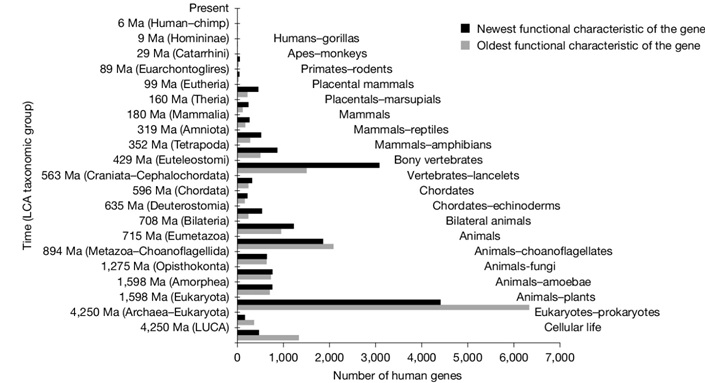
...these findings indicate that ...the tiny sparks made by crashing waves or waterfalls ...jump-started life on this planet. New research from Stanford University adds evidence—and a new angle—to the much-disputed Miller-Urey hypothesis.
 "'Microlightning' ...may have sparked life on Earth," Stanford University via Phys.Org, 14 Mar 2025: re: "'Microlightning' ...may have sparked life on Earth," Stanford University via Phys.Org, 14 Mar 2025: re:
 "Spraying of water microdroplets forms luminescence and causes chemical reactions in surrounding gas," by Yifan Meng et al, Science Advances, 14 Mar 2025. "Spraying of water microdroplets forms luminescence and causes chemical reactions in surrounding gas," by Yifan Meng et al, Science Advances, 14 Mar 2025.
 The RNA World and Other Origin-of-Life Theories mentions many suggestions for how life's hardware originated. The RNA World and Other Origin-of-Life Theories mentions many suggestions for how life's hardware originated.
 24 March 2011: earlier reconsderation of Miller-Urey, with skeptical comments. 24 March 2011: earlier reconsderation of Miller-Urey, with skeptical comments.
Life that could live under the ice of Europa or Enceladus?
 "Oceans' trenches are home to 'incredible' diversity," by Phie Jacobs and Elizabeth Pennisi, Science, 06 Mar 2025. "Oceans' trenches are home to 'incredible' diversity," by Phie Jacobs and Elizabeth Pennisi, Science, 06 Mar 2025.
 Bacteria:... has lots about their surprising survival capabilities. Bacteria:... has lots about their surprising survival capabilities.
 Life on Europa... has links about ice-covered moons. Life on Europa... has links about ice-covered moons.
 "Did Mars harbour life? ...signs in a peculiar rock," by Alexandra Witze, Nature, 12 Mar 2025. "Did Mars harbour life? ...signs in a peculiar rock," by Alexandra Witze, Nature, 12 Mar 2025.
 Life on Mars! has related evidence. Life on Mars! has related evidence.
| 13 Mar 2025 |
What'sNEW about HGT


|
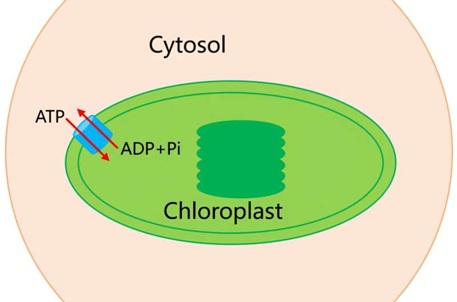 The mechanism that transports ATP across the chloroplast membrane in plants is the subjeect of a study by an interdisciplinary team in China. The insights gained could lead to benefits such as improved crop yields and new drug develompment, they say. A crucial piece of this intricate machinery is a highly specific NTT protein.
The mechanism that transports ATP across the chloroplast membrane in plants is the subjeect of a study by an interdisciplinary team in China. The insights gained could lead to benefits such as improved crop yields and new drug develompment, they say. A crucial piece of this intricate machinery is a highly specific NTT protein.
 "Structure and mechanism of the plastid/parasite ATP/ADP translocator," by Lin, H., Huang, J., Li, T. et al, doi:10.1038/s41586-025-08743-3, Nature, 12 Mar 2025. "Structure and mechanism of the plastid/parasite ATP/ADP translocator," by Lin, H., Huang, J., Li, T. et al, doi:10.1038/s41586-025-08743-3, Nature, 12 Mar 2025.
 "Scientists explain energy transfer mechanism in chloroplasts and its evolution," Chinese Academy of Sciences and Phys.Org, 12 Mar 2025. "Scientists explain energy transfer mechanism in chloroplasts and its evolution," Chinese Academy of Sciences and Phys.Org, 12 Mar 2025.
 Thanks, Google Alerts.
A long-standing question has been the origin of the NTT protein in chloroplasts, they write in linked commentary, ("Scientists explain..."). This gets my full attention: Thanks, Google Alerts.
A long-standing question has been the origin of the NTT protein in chloroplasts, they write in linked commentary, ("Scientists explain..."). This gets my full attention:
 One hypothesis suggests that an ancestral eukaryotic cell engulfed both a cyanobacterium and a Chlamydia-like bacterium. The cyanobacterium may have acquired an NTT protein from Chlamydia through horizontal gene transfer.... This is follwed by deep and careful scrutiny, which eventually concludes:
One hypothesis suggests that an ancestral eukaryotic cell engulfed both a cyanobacterium and a Chlamydia-like bacterium. The cyanobacterium may have acquired an NTT protein from Chlamydia through horizontal gene transfer.... This is follwed by deep and careful scrutiny, which eventually concludes:
 This supports the hypothesis that the chloroplast NTT protein originated from a Chlamydia-like ancestor. That is, a plausible ancestor protein, with similar capabilities and structure has been identified. And that's how it originated? No. Where it came from has been inferentially traced to an NTT ancestor, and no farther. Fred Hoyle once remarked that the word origin always aroused his suspicion.
This supports the hypothesis that the chloroplast NTT protein originated from a Chlamydia-like ancestor. That is, a plausible ancestor protein, with similar capabilities and structure has been identified. And that's how it originated? No. Where it came from has been inferentially traced to an NTT ancestor, and no farther. Fred Hoyle once remarked that the word origin always aroused his suspicion.
 Testing Darwinism versus Cosmic Ancestry has related discussion. Testing Darwinism versus Cosmic Ancestry has related discussion.
| 11 Mar 2025 |
What'sNEW about HGT


|
Genes from other organisms such as fungi, bacteria, plants, and viruses are commonly integrated into the insect genome through HGT. This fact is not in dispute, but how important is HGT for the evolution of eukaryotes? The answer has implications for the theory of evolution.
For review, HGT is "all there is" for the evolution of prokaryotes. (Ernst Mayr said these words to me 25 years ago.) Extensive, undisputed evidence now supports this statement, but its significance has not sunk in. The evidential tipping point, for me, was a computer analysis that attempted to match the graph of gene distribution in E. coli. The graph showed that a few genes were always present, the "core genome," but far more genes were only found once, the "pan-genome." The successful computer model ignored duplication-and-divergence and de novo gene creation, and relied on HGT exclusively.
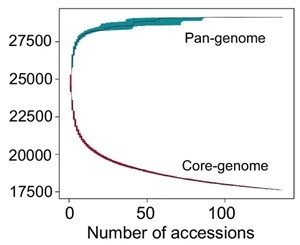 Now Chinese biologists have analysed the genomes of different strains of a worm that threatens agriculture. They divide the worm genes into four categories instead of two, and the core group is a much larger fraction of the total than was found in E. coli. But the story is similar. There's even a U-shaped graph. I suggest that, for eukaruotes as well, in order to acquire new genes, HGT may be "all there is."
Now Chinese biologists have analysed the genomes of different strains of a worm that threatens agriculture. They divide the worm genes into four categories instead of two, and the core group is a much larger fraction of the total than was found in E. coli. But the story is similar. There's even a U-shaped graph. I suggest that, for eukaruotes as well, in order to acquire new genes, HGT may be "all there is."
 "The pan-genome of Spodoptera frugiperda provides new insights into genome evolution and horizontal gene transfer," by Huang, YX., Rao, HY., Su, BS. et al, doi:10.1038/s42003-025-07707-7, Commun Biol, 11 Mar 2025. "The pan-genome of Spodoptera frugiperda provides new insights into genome evolution and horizontal gene transfer," by Huang, YX., Rao, HY., Su, BS. et al, doi:10.1038/s42003-025-07707-7, Commun Biol, 11 Mar 2025.
 Thanks, Google Alerts. Thanks, Google Alerts.
 10 Mar 2021: New [prokaryotic] genes can be acquired only via HGT.... 10 Mar 2021: New [prokaryotic] genes can be acquired only via HGT....
 Viruses... has links to thousands of examples of HGT across all domains of life. Viruses... has links to thousands of examples of HGT across all domains of life.
Methane on Mars could come from methanogenic bacteria. This opinion is reinforced following research that asks whether Mars has environments with the water, nutrients and shelter that methanogens require. The 16-page study, by an interdisciplinary team in Barcelona, is very comprehensive.
 "Potential Habitability of Present-Day Martian Subsurface for Earth-Like Methanogens," by Andrea Butturini et al, doi:10.1089/ast.2024.0100, Astrobiology, (also arXiv}, accessed 08 Mar 2025. "Potential Habitability of Present-Day Martian Subsurface for Earth-Like Methanogens," by Andrea Butturini et al, doi:10.1089/ast.2024.0100, Astrobiology, (also arXiv}, accessed 08 Mar 2025.
 Life on Mars! has more. Search for methane. Life on Mars! has more. Search for methane.
 Thanks, Jim Powers, for reminding me that methanogens are archaea. Thanks, Jim Powers, for reminding me that methanogens are archaea.
Hemoglobin, an essential protein in red blood cells, comprises four subunits. How these subunits came to be joined together is the subject of a study by an first-rate international, interdisciplinary team. Using a deep genomics database to reconstruct the past, they conclude, a few genetic changes drove the evolution of Hb's complex structure and functions from its dimeric precursor. This is good news, because, In principle, molecular assemblies could arise and become more complex via neutral processes, but this scenario is unlikely if many mutations are required.
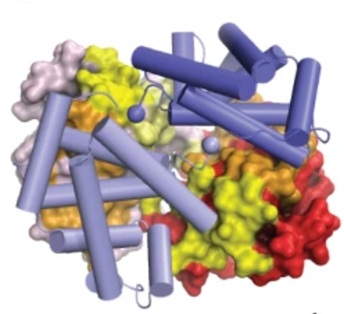
They note that the subunits have features that could not have been initially acquired because of selection for the functions of the final complex, because they existed before those functions first appeared. In spite of this hurdle, they close with reassurance, Although evolution of any particular molecular sequence or architecture without consistent selection for those properties is vanishingly improbable, our findings suggest that proteins evolve constantly through a dense space of possibilities in which complex new interactions and functional states are easily accessible.
What are they saying here? The gene for each of the subunits of hemoglobin is over a thousand nucleotides in length. Composing a gene that long by point blind mutations is vanishingly improbable, as Pillai et al. acknowledge. What they seem to be saying is that if the complex subunits are available, they can be properly pieced together by mutation and selection in only a few steps.
Cosmic ancestry says the same thing. If complex programming is installed in a few, large, compatible pieces, these can be pieced together and made functional by a genetic operating system. (I call it "robust software management.") Very many likely examples are known — that's why horizontal gene transfer (HGT) is effective. And the process would be easy to demonstrate in computer models. For example, a thousand-word text arbitrarily fragmented into half-a-dozen pieces could be reassembled with the syntax- grammar- and spell-check logic in a word processor. But it's a very different theory of evolution.
 "Origin of complexity in haemoglobin evolution," by Pillai, A.S., Chandler, S.A., Liu, Y. et al, doi:10.1038/s41586-020-2472-9, Nature, 28 May 2020. "Origin of complexity in haemoglobin evolution," by Pillai, A.S., Chandler, S.A., Liu, Y. et al, doi:10.1038/s41586-020-2472-9, Nature, 28 May 2020.
 21 May 2020: earlier comments about Pillai et al. 21 May 2020: earlier comments about Pillai et al.
 Testing Darwinism versus Cosmic Ancestry includes a brief discussion, "Reconstructing the Past Genomically." Testing Darwinism versus Cosmic Ancestry includes a brief discussion, "Reconstructing the Past Genomically."
 Robust Software Management introduces this term and the need for it. Robust Software Management introduces this term and the need for it.
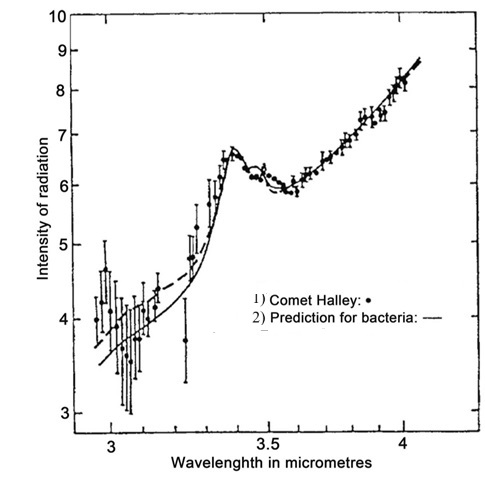 Evidence for bacterial life in comets gets a concise, wide-ranging, updated review from Chandra Wickramasinghe and two associates. The detection of dimethyl sulphide in the coma of Comet 67P Churyumov-Gerasimenko receives special attention. Also mentioned (see graph) is the match between the infrared emission spectra of 1) dust around Halley's comet and 2) desiccated E-coli. The overall case is strong, but science is conservative.
Evidence for bacterial life in comets gets a concise, wide-ranging, updated review from Chandra Wickramasinghe and two associates. The detection of dimethyl sulphide in the coma of Comet 67P Churyumov-Gerasimenko receives special attention. Also mentioned (see graph) is the match between the infrared emission spectra of 1) dust around Halley's comet and 2) desiccated E-coli. The overall case is strong, but science is conservative.
 "Evidence of microbiology in comets," by N. Chandra Wickramasinghe, Barry DiGregorio and Gensuke Tokoro, International Journal of Astronomy and Astrophysics [local pdf], Mar (online 26 Jan) 2025. "Evidence of microbiology in comets," by N. Chandra Wickramasinghe, Barry DiGregorio and Gensuke Tokoro, International Journal of Astronomy and Astrophysics [local pdf], Mar (online 26 Jan) 2025.
 Can The Theory Be Tested? introduces related discussion. Can The Theory Be Tested? introduces related discussion.
 Comets: The Delivery System has history and ~200 updates. Comets: The Delivery System has history and ~200 updates.
 Hoyle and Wickramasinghe's Analysis of Interstellar Dust has background and more evidence. Hoyle and Wickramasinghe's Analysis of Interstellar Dust has background and more evidence.
| 19 Feb 2025 |
What'sNEW about HGT


|
Plants acquire essential genes by horizontal gene transfer (HGT) from bacteria, as two more research projects reveal. With examples piling up, it looks like this is how life makes macroevolutionary advances. (If evolution can make major advances without HGT, where are the convincing examples?)
 "Discovery of bifunctional diterpene cyclases/synthases in bacteria supports a bacterial origin for the plant terpene synthase gene family," by Xinlu Chen et al, doi:10.1093/hr/uhae221, Horticulture Research, 03 Aug 2024; and "Ancient Bacterial Genes Linked to Plant Hormone Biosynthesis," Chinese Academy of Sciences via Newswise, 19 Feb 2025.
"These findings strongly suggest that the ancestral TPS in plants originated from a bacterial DCS gene fusion." "Discovery of bifunctional diterpene cyclases/synthases in bacteria supports a bacterial origin for the plant terpene synthase gene family," by Xinlu Chen et al, doi:10.1093/hr/uhae221, Horticulture Research, 03 Aug 2024; and "Ancient Bacterial Genes Linked to Plant Hormone Biosynthesis," Chinese Academy of Sciences via Newswise, 19 Feb 2025.
"These findings strongly suggest that the ancestral TPS in plants originated from a bacterial DCS gene fusion."
 "GRAS transcription factors regulate cell division planes in moss overriding the default rule," by Masaki Ishikawa et al, doi:10.1073/pnas.2210632120, PNAS, 20 Jan 2025.
"A gene encoding a GRAS transcription factor was transferred from soil bacteria to plants, and its descendent genes now regulate formative cell divisions in flowering plants. ...We propose that the acquisition of GRAS genes contributed to the genetic regulatory networks controlling cell division orientation in the ancestor of land plants, and this gene family then underwent expansion and adaptation in flowering plant and moss lineages to specify body plans." "GRAS transcription factors regulate cell division planes in moss overriding the default rule," by Masaki Ishikawa et al, doi:10.1073/pnas.2210632120, PNAS, 20 Jan 2025.
"A gene encoding a GRAS transcription factor was transferred from soil bacteria to plants, and its descendent genes now regulate formative cell divisions in flowering plants. ...We propose that the acquisition of GRAS genes contributed to the genetic regulatory networks controlling cell division orientation in the ancestor of land plants, and this gene family then underwent expansion and adaptation in flowering plant and moss lineages to specify body plans."
 Thanks, Google Alerts. Thanks, Google Alerts.
 Viruses... has links to thousands of examples of HGT across all domains of life. Viruses... has links to thousands of examples of HGT across all domains of life.
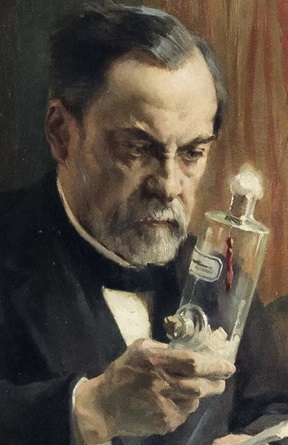 The world into which you wish to take us is really too fantastic. That's how a journalist reacted to Pasteur's claim that there are germs in the air, and they do not arise by spontaneous generation.
The world into which you wish to take us is really too fantastic. That's how a journalist reacted to Pasteur's claim that there are germs in the air, and they do not arise by spontaneous generation.
 Louis Pasteur's Relentless Hunt for Germs Floating in the Air, by Carl Zimmer, The New York Times, 17 Feb 2025 Louis Pasteur's Relentless Hunt for Germs Floating in the Air, by Carl Zimmer, The New York Times, 17 Feb 2025
 The RNA World has lots about modern theories of spontaneous generation. The RNA World has lots about modern theories of spontaneous generation.
 Louis Pasteur: a brief introduction. Louis Pasteur: a brief introduction.
In a brief paper, Chandra Wickramasinghe and Jayant Narlikar remind us of evidence for life from space.
 "Life Arriving from Space: Theory and Proof," by N.C. Wickramasinghe1 and J.V. Narlikar, ISSN (O)2795-8639, Current Science [local pdf], online 08 Feb 2025. "Life Arriving from Space: Theory and Proof," by N.C. Wickramasinghe1 and J.V. Narlikar, ISSN (O)2795-8639, Current Science [local pdf], online 08 Feb 2025.
 An Atmospheric Test of Cometary Panspermia discusses sample return from the high atmosphere. An Atmospheric Test of Cometary Panspermia discusses sample return from the high atmosphere.
 Comet Rendezvous has updates about sample return from interplanetary space. Comet Rendezvous has updates about sample return from interplanetary space.
 Chandra Wickramasinghe has an introductory essay and many updates. Chandra Wickramasinghe has an introductory essay and many updates.
| 10 Feb 2025 |
What'sNEW about HGT


|
Fungal accessory chromosomes can be horizontally transferred, representing a significant horizontal gene transfer (HGT) event, often encompassing hundreds of genes and, in addition, non-genic elements. "Accessory chromosomes are nonessential, linear chromosomes found in some but not all members of a population." They are characterized by a peculiar codon bias which can help identify other, previously unsuspected horizontal transfers of these chromosomes. Also, they "may encode the machinery required for their own horizontal transmission...." In new research, an international team has thus expanded the known extent of horizontal chromosome transfer among fungi. The article, available by Open Access, has useful background and references about HGT.
 "Horizontal transfer of accessory chromosomes in fungi - a regulated process for exchange of genetic material?" by Habig, M., Patneedi, S.K., Stam, R. et al, Nature (also: epdf), 10 Feb 2025.
The transfer of whole chromosomes among fungi was already known, but almost ignored for its implications. In a single transfer, hundreds of genes may be delivered to species lacking them. This would be a wholesale example of how evolution by cosmic ancestry uses HGT. "Horizontal transfer of accessory chromosomes in fungi - a regulated process for exchange of genetic material?" by Habig, M., Patneedi, S.K., Stam, R. et al, Nature (also: epdf), 10 Feb 2025.
The transfer of whole chromosomes among fungi was already known, but almost ignored for its implications. In a single transfer, hundreds of genes may be delivered to species lacking them. This would be a wholesale example of how evolution by cosmic ancestry uses HGT.
 Viruses... has links to more than a thousand examples of HGT benefitting eukaryotes. Viruses... has links to more than a thousand examples of HGT benefitting eukaryotes.
| 07 Feb 2025 |
What'sNEW about HGT


|
...a large exogenous bacterial chromosome placed in a eukaryotic context spontaneously adopts eukaryotic chromatin features....
French specialists in genomics and related fields observe this, following experiments introducing bacterial DNA into yeast cells. Perhaps the acquisition of diverse sequences very long ago led to eukaryotic chromatin compartmentalization? The whole subject of eukaryotic DNA supplied by HGT is waiting for exploration.
 "Sequence-dependent activity and compartmentalization of foreign DNA in a eukaryotic nucleus," by Léa Meneu, Christophe Chapard et al, doi:10.1126/science.adm9466; and "Relating DNA sequence, organization, and function" [commentary], by Geoffrey Fudenberg and Vijay Ramani, Science, 07 Feb 2025. "Sequence-dependent activity and compartmentalization of foreign DNA in a eukaryotic nucleus," by Léa Meneu, Christophe Chapard et al, doi:10.1126/science.adm9466; and "Relating DNA sequence, organization, and function" [commentary], by Geoffrey Fudenberg and Vijay Ramani, Science, 07 Feb 2025.
 Viruses... has a primer and links about HGT from bacteria to eukaryotes. Viruses... has a primer and links about HGT from bacteria to eukaryotes.
| 04 Feb 2025 |
What'sNEW about HGT


|
 ...multiple independent events of microbe-to-beetle HGT and specialized symbioses drove convergent evolutionary innovations in approximately 21,000 and 13,500 leaf beetle species, respectively.
This statement comes from an international consortium including veteran entomologists and evolutionary biologists. Their new report makes clear that HGT is a frequent contributor to evolutionary advances in these eukaryotes.
...multiple independent events of microbe-to-beetle HGT and specialized symbioses drove convergent evolutionary innovations in approximately 21,000 and 13,500 leaf beetle species, respectively.
This statement comes from an international consortium including veteran entomologists and evolutionary biologists. Their new report makes clear that HGT is a frequent contributor to evolutionary advances in these eukaryotes.
 "Symbiosis and horizontal gene transfer promote herbivory in the megadiverse leaf beetles," by Roy Kirsch et al, doi:10.1016/j.cub.2024.12.028; and "Insect herbivory..." [commentary], by Noah K. Whiteman, Current Biology, 03 Feb 2025. "Symbiosis and horizontal gene transfer promote herbivory in the megadiverse leaf beetles," by Roy Kirsch et al, doi:10.1016/j.cub.2024.12.028; and "Insect herbivory..." [commentary], by Noah K. Whiteman, Current Biology, 03 Feb 2025.
 Thanks, Google Alerts. Thanks, Google Alerts.
...among the most compelling detections were amino acids – 14 of the 20 that life on Earth uses to make proteins – and all five nucleobases that life on Earth uses to store and transmit genetic instructions....
This comment comes from Glavin et al., one of two large interdisciplinary teams who have analysed samples returned from asteroid Bennu. Fifty years ago, all of the organics would have been thought incredible, but this surprise has been gradually accepted and explained. Now they are considered to be ingredients for the Earthly origin of life, a concept I call pseudo-panspermia. With my opposite gestalt, I suspect that these life-related molecules actually came from life — the simplest way to explain them. I would be surprised if no signs of life were found in space.
The other team (McCoy et al.) was focussed on the minerals in the samples, which must have precipitated from a watery brine on Bennu's parent body. The evidence for liquid water in the asteroids and moons of our solar system is another ongoing surprise that also looks favorable for panspermia. Analysis of the valuable Bennu samples is not complete.
|
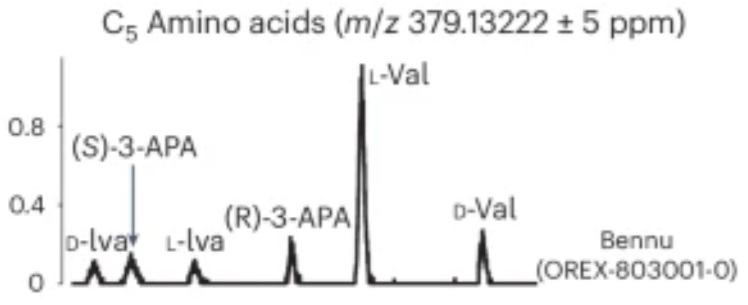 Bennu's valine exhibits life's chiralty (Glavin et al.)
Bennu's valine exhibits life's chiralty (Glavin et al.)
|
 "Abundant ammonia and nitrogen-rich soluble organic matter in samples from asteroid (101955) Bennu," by Glavin, D.P., Dworkin, J.P., Alexander, C.M.O. et al, doi:10.1038/s41550-024-02472-9, Nature Astronomy, 29 Jan 2025. "Abundant ammonia and nitrogen-rich soluble organic matter in samples from asteroid (101955) Bennu," by Glavin, D.P., Dworkin, J.P., Alexander, C.M.O. et al, doi:10.1038/s41550-024-02472-9, Nature Astronomy, 29 Jan 2025.
 "An evaporite sequence from ancient brine recorded in Bennu samples," by McCoy, T.J., Russell, S.S., Zega, T.J. et al, doi:10.1038/s41586-024-08495-6, Nature, 29 Jan 2025; and commentary: "An evaporite sequence from ancient brine recorded in Bennu samples," by McCoy, T.J., Russell, S.S., Zega, T.J. et al, doi:10.1038/s41586-024-08495-6, Nature, 29 Jan 2025; and commentary:
 "NASA's Asteroid Bennu Sample Reveals Mix of Life's Ingredients," by Jessica Taveau, NASA, 29 Jan 2025. "NASA's Asteroid Bennu Sample Reveals Mix of Life's Ingredients," by Jessica Taveau, NASA, 29 Jan 2025.
 "Bennu asteroid...," by Timothy J McCoy and Sara Russell, The Conversation and Smithsonian, 29 Jan 2025. "Bennu asteroid...," by Timothy J McCoy and Sara Russell, The Conversation and Smithsonian, 29 Jan 2025.
 "Lurking Inside an Asteroid: Life's Ingredients," by Carl Zimmer, The New York Times, 29 Jan 2025. "Lurking Inside an Asteroid: Life's Ingredients," by Carl Zimmer, The New York Times, 29 Jan 2025.
 "Asteroid Bennu contains salts from ancient brine," by Yasuhito Sekine, Nature, 29 Jan 2025. "Asteroid Bennu contains salts from ancient brine," by Yasuhito Sekine, Nature, 29 Jan 2025.
 "Are we all aliens?...," by Marcia Dunn, Phys.Org, 01 Feb 2025. "Are we all aliens?...," by Marcia Dunn, Phys.Org, 01 Feb 2025.
 Thanks for alerts, Patsy Welch and Kenneth Augustyn. Thanks for alerts, Patsy Welch and Kenneth Augustyn.
 09 Oct 2020: background on the mission to Bennu. 09 Oct 2020: background on the mission to Bennu.
 Comet Rendezvous has discussion and updates (search for "Bennu"). Comet Rendezvous has discussion and updates (search for "Bennu").
 Comets: The Delivery System has background and related discussion. Comets: The Delivery System has background and related discussion.
![]()
|

![]() "The Ethics of Spreading Life in the Cosmos," by Paul Gilster, Centauri Dreams, 25 Mar 2025.
"The Ethics of Spreading Life in the Cosmos," by Paul Gilster, Centauri Dreams, 25 Mar 2025.


 The mechanism that transports ATP across the chloroplast membrane in plants is the subjeect of a study by an interdisciplinary team in China. The insights gained could lead to benefits such as improved crop yields and new drug develompment, they say. A crucial piece of this intricate machinery is a highly specific NTT protein.
The mechanism that transports ATP across the chloroplast membrane in plants is the subjeect of a study by an interdisciplinary team in China. The insights gained could lead to benefits such as improved crop yields and new drug develompment, they say. A crucial piece of this intricate machinery is a highly specific NTT protein.
 Now Chinese biologists have analysed the genomes of different strains of a worm that threatens agriculture. They divide the worm genes into four categories instead of two, and the core group is a much larger fraction of the total than was found in E. coli. But the story is similar. There's even a U-shaped graph. I suggest that, for eukaruotes as well, in order to acquire new genes, HGT may be "all there is."
Now Chinese biologists have analysed the genomes of different strains of a worm that threatens agriculture. They divide the worm genes into four categories instead of two, and the core group is a much larger fraction of the total than was found in E. coli. But the story is similar. There's even a U-shaped graph. I suggest that, for eukaruotes as well, in order to acquire new genes, HGT may be "all there is."



 ...multiple independent events of microbe-to-beetle HGT and specialized symbioses drove convergent evolutionary innovations in approximately 21,000 and 13,500 leaf beetle species, respectively.
This statement comes from an international consortium including veteran entomologists and evolutionary biologists. Their new report makes clear that HGT is a frequent contributor to evolutionary advances in these eukaryotes.
...multiple independent events of microbe-to-beetle HGT and specialized symbioses drove convergent evolutionary innovations in approximately 21,000 and 13,500 leaf beetle species, respectively.
This statement comes from an international consortium including veteran entomologists and evolutionary biologists. Their new report makes clear that HGT is a frequent contributor to evolutionary advances in these eukaryotes.
